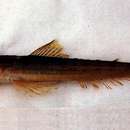Diagnostic Description
provided by Fishbase
This species is distinguished from its congeners by the following characters: snout length (LSn) 53.2-117.0% eye diameter (DE), mean 79.1% (vs. mean 40.1% in T. gauguini and 74.8% in T. trachinus); LSn 13.5-27.0% body depth (DB), mean 21.6 (vs. mean 14.7% in T. gauguini); interorbital width 3.4-11.9%, mean 8.9% LH (vs. mean 5.6% in T. gauguini); DE 10.8-21.7% LH, mean 15.7% (vs. mean 16·6% in T. trachinus); lengthof the last dorsal-fin ray 7.3-11.6% LS, mean 9·4% (vs. mean 10.1% in T. trachinus and 10.8% in T. gauguini); anal-fin rays 13-16, mode 15 (vs. mode 14 in T. gauguini and 16 in T. trachinus); pectoral-fin rays 11-13, mode 12 (vs. mode 11 in T. gauguini); lateral-line scales 53-60, mode 57 (vs. mode 56 in T. gauguini); predorsal scales 15-20, mode 17 (vs. mode 16 in T. trachinus); further differs from T. gauguini and T. trachinus by deep mitochondrial distances (16.9-17.6 and 15.1-17.8%, respectively) (Ref. 110386).
- Recorder
- Estelita Emily Capuli
Trophic Strategy
provided by Fishbase
Found over sandy bottoms of deep outer reef slopes. Reported to be common in estuaries. Rests on or burrows into substrate, leaving eyes exposed.
- Recorder
- Drina Sta. Iglesia
Biology
provided by Fishbase
Rest on or more often burrow into substrate, leaving eyes exposed (Ref. 4472).
Importance
provided by Fishbase
fisheries: minor commercial; price category: medium; price reliability: very questionable: based on ex-vessel price for species in this family
分布
provided by The Fish Database of Taiwan
分布區域除東太平洋海域外,其他溫、熱帶海域均有分布(40°N-40°S)。臺灣四週海域均產。
利用
provided by The Fish Database of Taiwan
漁期全年皆有,可利用流刺網、底拖網等漁法捕獲,本種肉味稍差,切薑片燉煮或炒九層塔等,會有特殊的風味。
描述
provided by The Fish Database of Taiwan
體長圓形而瘦長,吻短而鈍,其長短於眼經。口裂大,口裂大,上頜骨末端遠延伸至眼後方,下頜略長於上頜;兩頜齒多列,呈帶狀。體及頭部被圓鱗;頰部及鰓蓋皆被鱗;側線鱗數
53-58;側線上鱗數
3.5。單一背鰭,具軟條12-13;有脂鰭;臀鰭與脂鰭相對,具軟條15-17;胸鰭短,末端不延伸至腹鰭起點與背鰭起點之連線;尾鰭叉形,上葉等長於下葉。體側背部呈淡黃色,腹面呈白色,體側有數列青藍色的縱帶;鰓蓋後上緣具一暗褐色斜斑。
棲地
provided by The Fish Database of Taiwan
性喜棲息於岩礁或珊瑚礁區外砂泥底質之大陸棚海域,從沿岸可達100公尺深均有。肉食性,常將身體埋入砂泥地中,只露出眼睛,掠食游經其上的小魚。
Trachinocephalus trachinus
provided by wikipedia EN
Trachinocephalus trachinus, also known as the Indo-Pacific blunt-nose lizardfish is a species of fish in the family Synodontidae found in Indo-Pacific. Although previously synonymized with T. myops, Polanco et al. (2016) demonstrated that the two are distinct in the number of lateral-line scales and other meristics, and resurrected T. trachinus for the Indo-Pacific population.[1] This species grows to a length of 40 centimetres (16 in) TL.[2]
References
-
^ Polanco F., A., Acero P., A. & Betancur-R., R. (2016): No longer a circumtropical species: revision of the lizardfishes in the Trachinocephalus myops species complex, with description of a new species from the Marquesas Islands. Journal of Fish Biology, 89 (2): 1302-1323.
-
^ Froese, Rainer; Pauly, Daniel (eds.) (2016). "Trachinocephalus myops" in FishBase. June 2016 version.

- license
- cc-by-sa-3.0
- copyright
- Wikipedia authors and editors
Trachinocephalus trachinus: Brief Summary
provided by wikipedia EN
Trachinocephalus trachinus, also known as the Indo-Pacific blunt-nose lizardfish is a species of fish in the family Synodontidae found in Indo-Pacific. Although previously synonymized with T. myops, Polanco et al. (2016) demonstrated that the two are distinct in the number of lateral-line scales and other meristics, and resurrected T. trachinus for the Indo-Pacific population. This species grows to a length of 40 centimetres (16 in) TL.
- license
- cc-by-sa-3.0
- copyright
- Wikipedia authors and editors
Description
provided by World Register of Marine Species
Inhabits deeper waters on the outer slopes of the reef. Found over sandy areas of coastal waters, from the littoral zone down to a depth of about 100 m. Feeds on fishes (Ref. 5213). Rests on or burrows into substrate, leaving eyes exposed (Ref. 4472).
Froese, R. & D. Pauly (Editors). (2023). FishBase. World Wide Web electronic publication. version (02/2023).
- license
- cc-by-4.0
- copyright
- WoRMS Editorial Board
Diet
provided by World Register of Marine Species
Feed on fishes and small crustaceans
North-West Atlantic Ocean species (NWARMS)
- license
- cc-by-4.0
- copyright
- WoRMS Editorial Board
Distribution
provided by World Register of Marine Species
Grand Bank to Florida, Bahamas, Gulf of Mexico, Antilles, and Caribbean south to Brazil
North-West Atlantic Ocean species (NWARMS)
- license
- cc-by-4.0
- copyright
- WoRMS Editorial Board
Habitat
provided by World Register of Marine Species
Found over sandy bottoms of deep outer reef slopes. Reported to be common in estuaries. Rest on or more often burrow into substrate, leaving eyes exposed.
North-West Atlantic Ocean species (NWARMS)
- license
- cc-by-4.0
- copyright
- WoRMS Editorial Board
Habitat
provided by World Register of Marine Species
benthic
North-West Atlantic Ocean species (NWARMS)
- license
- cc-by-4.0
- copyright
- WoRMS Editorial Board

